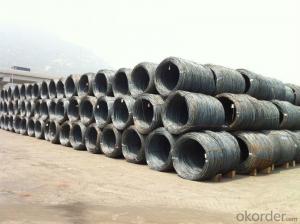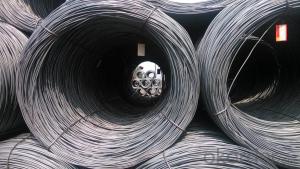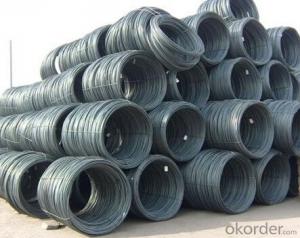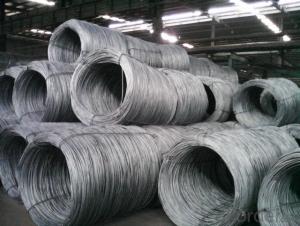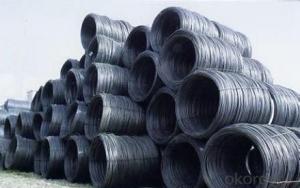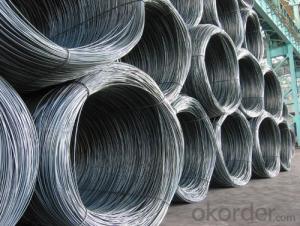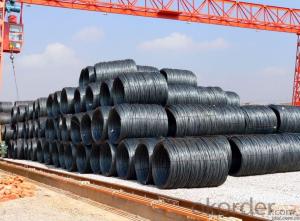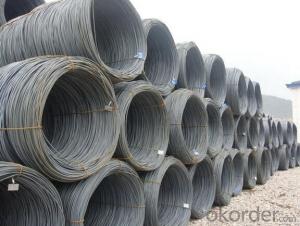Supply 10mm steel wire rod in coils with competitive price
- Loading Port:
- Tianjin
- Payment Terms:
- TT OR LC
- Min Order Qty:
- 25 m.t.
- Supply Capability:
- 500000 m.t./month
OKorder Service Pledge
OKorder Financial Service
You Might Also Like
Specification
Steel Grade: Q195/235, SAE1006-1018B Standard: ASTM, GB
Diameter: 5.5mm, 6.5mm, 7mm,8mm,9mm,10mm,12mm,14mm
Type: Drawn Wire Alloy or Not: Alloy Brand Name: HSKY
Technique: Hot Rolled Place of Origin: China Mainland
Chemical Composition:(Please kindly find our chemistry of our material based on SAE1006B and SAE1008B as below for your information)
High carbon/Low carbon/common carbon Steel wire rod | With boron for rebate tax |
Grade | SAE1006B SAE1008B SAE1018B |
Package | In coil ,in bundle, |
Coil weight | about 2000kg-3000kgs |
Size: | 5.5mm 6.5mm 8mm 10mm 12mm 14mm 16mm |
Types | High Carbon ,Low carbon ,Common carbon |
Exported Country | South Korea,Vietnam,Indonesia,Myanmar,Philippines and Afrca,Ect |
Delivery term: | within 30 days after receive the LC |
Payment Term: | LC at sight ,LC 30-120 days after B/L date, TT payment |
The Standard of Physical Properties:
Grade | Chemical Composition(%) | |||||
C | Mn | Si | S | P | Cr | |
SAE1006 | 0.03~O.07 | ≤0.32 | ≤0.30 | ≤0.045 | ≤0.040 | >0.30 |
Mechanical properties | ||||||
Yield strength(N/mm2) | Tensile strength(N/mm2) | Elongation(%) | ||||
250-280 | 350-380 | ≥32 | ||||
Grade | Chemical Composition(%) | |||||
C | Mn | Si | S | P | Cr | |
SAE1008 | 0.10max | 0.3~O.50 | 0.15max | 0.050max | 0.040 max | 0.30 min |
Mechanical properties | ||||||
Yield strength(N/mm2) | Tensile strength(N/mm2) | Elongation(%) | ||||
≥195 | 315-430 | ≥30 | ||||
Usage and Applications of Steel Wire Rod in Coil:
After hot-rolled the products shaped into coil and delivery as finished product, including round, square, rectangular, hexagonal and so on, Since most of the products are round, it is generally called wire rod. Steel wire rod is widely used in construction and manufacturing. Steel wire rod is mainly used for reinforcement of reinforced concrete and welded structure or reprocessed (roberts, nail etc) materials, especially used to produce wire drawing, welding electrode, nails,spring, electronic, precise machinery parts and so on.
Packaging & Delivery of Steel Wire Rod in Coil:
Packaging Detail: products are packed in coil and then shipped by container or bulk vessel
Each coil weight: 2-3MT
Delivery Detail: within 45 days after received deposit or LC.
Label: to be specified by customer, generally, each bundle has 1-2 labels
Trade terms: CFR, CIF

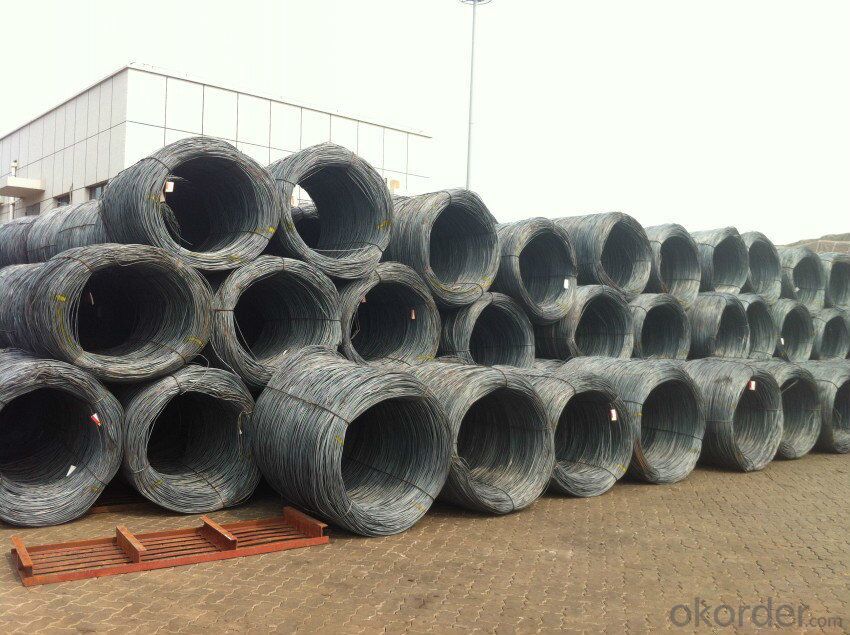
- Q: How is steel wire rod used in the production of wire ropes?
- Steel wire rod is the primary raw material used in the production of wire ropes. It is first drawn into a thin wire and then twisted and braided together to form the strands of the wire rope. The strength and durability of the wire rod ensure that the resulting wire rope can withstand heavy loads and provide reliable support in various applications like construction, mining, and transportation.
- Q: What are the common sizes of steel wire rod?
- The size of steel wire rods differs depending on the specific application and industry requirements. However, there are commonly utilized sizes of steel wire rods with diameters ranging from 5.5mm to 20mm. These sizes are typically employed in the production of various items, including wire ropes, springs, nails, screws, and reinforcement bars for construction purposes. Moreover, steel wire rods can also be found in larger diameters that exceed 20mm, which are suitable for heavy-duty applications such as prestressed concrete structures and suspension bridges. It is worth noting that the sizes of steel wire rods can vary by region and industry standards, so it is advisable to refer to the relevant specifications and standards for accurate information.
- Q: What are the different types of steel wire rod surface defects and their detection methods?
- During the manufacturing process, various types of defects can occur on the surface of steel wire rods. These defects can have a significant impact on the quality and integrity of the wire rods, so it is crucial to identify and address them before they cause further issues. Here are some common surface defects of steel wire rods and the methods used to detect them: 1. Scale: Oxide layers can form on the surface of wire rods due to exposure to high temperatures during production. Scale can be visually detected by looking for discoloration or by performing a scratch test to see if the scale flakes off easily. 2. Cracks: Surface cracks can be caused by factors like improper cooling, excessive stress, or material defects. Visual inspection is commonly used to detect cracks, but more accurate methods like magnetic particle inspection or ultrasonic testing can also be utilized. 3. Pitting: Pitting refers to small depressions or cavities that form on the surface of wire rods due to corrosion or mechanical damage. Visual inspection is usually sufficient to identify pitting, but techniques like dye penetrant inspection or eddy current testing can be employed for a more detailed examination. 4. Surface roughness: Irregular or uneven texture on the surface of wire rods is known as surface roughness. It can be a result of improper manufacturing processes or inadequate quality control. Visual inspection or the use of a profilometer to measure roughness quantitatively can help detect surface roughness. 5. Inclusions: Non-metallic substances, such as slag, dirt, or oxide particles, can become embedded in the surface of wire rods, causing weak spots or affecting mechanical properties. Visual inspection can identify large inclusions, while microscopic examination or techniques like X-ray inspection can detect smaller or subsurface inclusions. 6. Coating defects: If a wire rod has a coating, defects like peeling, blistering, or uneven thickness can occur. Visual inspection is generally sufficient, but techniques like ultrasonic testing or electrical conductivity measurements can provide a more comprehensive assessment. It is important to note that while visual inspection is commonly used, more advanced non-destructive testing (NDT) methods can offer more accurate and reliable detection of surface defects. By employing a combination of these methods, the identification and rectification of surface defects in steel wire rods can be ensured, ultimately enhancing their quality and performance.
- Q: How is steel wire rod used in the manufacturing of wire ties for construction sites?
- Steel wire rod is an essential component in the manufacturing of wire ties for construction sites. These wire ties are widely used in the construction industry for various purposes, such as securing rebar, reinforcing concrete structures, and fastening construction materials together. The steel wire rod serves as the raw material for producing wire ties. It undergoes a series of processes to transform it into the final product. First, the wire rod is cleaned and coated to enhance its corrosion resistance. This coating, often made of zinc, provides an added layer of protection against rust and ensures the wire tie's longevity in harsh construction environments. Next, the coated steel wire rod is fed into a wire drawing machine where it is pulled through a die to reduce its diameter to the desired size. This process is repeated several times to achieve the required wire thickness and strength. Once the wire is drawn to the desired gauge, it is then cut into appropriate lengths to produce individual wire ties. These lengths can vary depending on the specific application and requirements of the construction project. The wire is then bent, twisted, or formed into the shape of a tie using specialized machinery. Wire ties made from steel wire rod offer exceptional strength, durability, and flexibility. They can be easily bent or twisted to fit around various construction materials, ensuring a secure and tight connection. Moreover, the high tensile strength of steel wire rod ensures that the wire ties can withstand considerable stress and load without breaking or deforming. The wire ties manufactured from steel wire rod are commonly used in construction sites to secure and fasten rebar during concrete pouring. They are also used to reinforce concrete structures, such as walls, columns, and beams. Additionally, wire ties are employed to bundle or tie together construction materials, including pipes, cables, and electrical wires, ensuring proper organization and preventing potential hazards. In summary, steel wire rod plays a crucial role in the manufacturing of wire ties for construction sites. These wire ties provide essential support and reinforcement in various construction applications, offering durability, flexibility, and strength to ensure the safety and stability of construction projects.
- Q: How is the tensile strength of steel wire rod tested?
- The tensile strength of steel wire rod can be assessed through a method known as the tensile test or tension test. This test aims to ascertain the wire rod's ability to withstand tension by determining the maximum load or force it can endure without breaking. In the process of the tensile test, a representative sample of the steel wire rod is prepared through cutting it into a specific length. Subsequently, the sample is placed within a testing machine referred to as a tensile testing machine or universal testing machine. This machine comprises two jaws, one stationary and one movable, which securely grip the ends of the wire rod. Once the sample is suitably positioned in the testing machine, the movable jaw is gradually pulled away from the stationary jaw, exerting an increasing force on the wire rod. The machine gauges the force applied to the sample while simultaneously recording the resulting elongation or deformation of the wire rod. Throughout the duration of the test, the force and elongation are continuously monitored until the wire rod fractures. The maximum force applied just before the fracture is noted as the tensile strength of the steel wire rod. This value signifies the highest load or stress the wire rod can withstand without breaking. To ensure precise and dependable outcomes, multiple samples are typically tested to account for any variability in material properties. The average of these results is then considered as the representative tensile strength of the steel wire rod. In conclusion, the tensile strength of steel wire rod is determined through a controlled testing process utilizing a tensile testing machine. This machine measures the maximum force applied to the sample before it fractures, providing valuable insights into the material's strength and performance.
- Q: What are the common production processes for lead-coated steel wire rod?
- The common production processes for lead-coated steel wire rod typically include wire drawing, cleaning and pickling, lead coating, and final inspection.
- Q: How is the ductility of steel wire rod evaluated?
- To assess the ductility of steel wire rod, a common method is to perform a tensile test. This test involves applying a controlled pulling force to a sample of the steel wire rod until it reaches its breaking point. Throughout the test, the elongation or deformation of the sample is measured to gauge the ductility of the material. The ductility is then determined by calculating the percentage of elongation or reduction in cross-sectional area before the sample fractures. A higher percentage signifies greater ductility, whereas a lower percentage implies lower ductility. By utilizing this evaluation technique, manufacturers and engineers can effectively determine the appropriateness of steel wire rod for various applications, including construction, automotive, and manufacturing industries.
- Q: How is steel wire rod used in the manufacturing of wire mesh baskets?
- Steel wire rod is used in the manufacturing of wire mesh baskets as the primary raw material. It is first drawn into thinner wires, which are then woven or welded together to form the mesh structure of the basket. The strong and durable nature of steel wire rod ensures that the wire mesh baskets have sufficient strength and stability to hold various items securely.
- Q: How is steel wire rod used in the manufacturing of wire forms for elevator shafts?
- Steel wire rod is an essential component in the manufacturing of wire forms for elevator shafts. Elevator shafts require strong and durable materials to ensure the safety and reliability of the elevator system. Steel wire rod, which is a long cylindrical steel product, is commonly used in this process due to its inherent strength and flexibility. Firstly, steel wire rod is used as the primary raw material for manufacturing wire forms for elevator shafts. The wire rod undergoes several processes, including drawing, annealing, and surface treatment, to enhance its mechanical properties and surface finish. These processes help to refine the steel wire rod and make it suitable for further manufacturing. Once the steel wire rod is prepared, it is formed into various wire shapes that are specifically designed for elevator shafts. These wire forms can include guide rails, safety ropes, suspension cables, and counterweight ropes, among others. Each wire form serves a crucial function in the elevator system, contributing to its smooth operation and ensuring the safety of passengers. The wire forms made from steel wire rod are known for their high tensile strength, which is essential for withstanding the heavy loads and constant movement experienced by elevator systems. The wires must be able to support the weight of the elevator car and its occupants while maintaining their structural integrity over time. Steel wire rod provides the necessary strength and durability to meet these requirements. Furthermore, steel wire rod offers excellent flexibility and elasticity, allowing the wire forms to withstand the dynamic movements of the elevator system. Elevators experience constant vertical and horizontal motions, as well as vibrations, which can put stress on the wire forms. Steel wire rod's flexibility helps to absorb and distribute these forces, reducing the risk of damage or failure. In addition to its mechanical properties, steel wire rod is also corrosion-resistant, providing long-lasting performance in elevator shafts. Elevator systems are often exposed to various environmental factors, such as humidity and temperature changes, which can cause corrosion and deterioration. By using steel wire rod, manufacturers can ensure that the wire forms will remain reliable and safe for an extended period. In conclusion, steel wire rod plays a vital role in the manufacturing of wire forms for elevator shafts. Its high tensile strength, flexibility, and corrosion resistance make it an ideal material for producing wire forms that can withstand the demanding conditions of elevator systems. By utilizing steel wire rod, manufacturers can create safe and durable wire forms that contribute to the smooth operation of elevators and the security of passengers.
- Q: How is steel wire rod used in the manufacturing of wire racks?
- Wire racks rely heavily on steel wire rod, which acts as the main material for constructing the rack's framework and structure. To transform the wire rod into a long, thin wire, it goes through a series of steps such as heating, rolling, and drawing. This wire is then bent, shaped, and welded to create the different parts of the wire rack, including the sides, shelves, and supports. Due to its high tensile strength and durability, steel wire rod is a perfect choice for wire racks. It can withstand heavy loads and constant use without bending or breaking. Additionally, its corrosion resistance properties ensure that the wire rack remains strong and long-lasting, even in environments with high humidity or moisture exposure. The versatility of steel wire rod allows manufacturers to produce wire racks in a variety of sizes and designs to accommodate different storage needs. Its malleability enables easy manipulation to form various shapes, making it possible to create wire racks with adjustable shelves or collapsible features. This adaptability in design makes wire racks highly customizable for use in different settings, such as homes, offices, warehouses, or retail stores. Moreover, the use of steel wire rod in wire rack manufacturing facilitates efficient production processes. With automated machinery, the wire rod can be easily cut, shaped, and welded, reducing production time and costs. This ease of manufacturing enables mass production, ensuring a steady supply to meet market demands. In conclusion, steel wire rod is essential in manufacturing wire racks due to its strength, durability, and versatility. Its ability to be easily shaped, resistance to corrosion, and cost-effectiveness make it an ideal material for creating wire racks of various sizes and designs.
Send your message to us
Supply 10mm steel wire rod in coils with competitive price
- Loading Port:
- Tianjin
- Payment Terms:
- TT OR LC
- Min Order Qty:
- 25 m.t.
- Supply Capability:
- 500000 m.t./month
OKorder Service Pledge
OKorder Financial Service
Similar products
Hot products
Hot Searches
Related keywords
